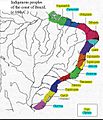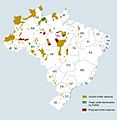Indigenous peoples in Brazil facts for kids
| Total population | |
|---|---|
| 996,917 0.6% of Brazil's population |
|
| Regions with significant populations | |
| Predominantly in the North and Central-West | |
| Languages | |
| Indigenous languages, Portuguese | |
| Religion | |
| Originally traditional beliefs and animism. 61.1% Roman Catholic, 19.9% Protestant, 11% non-religious, 8% other beliefs. Animist religions still widely practiced by isolated populations | |
| Related ethnic groups | |
| Other indigenous peoples of the Americas |
The Indigenous peoples in Brazil (called povos indígenas no Brasil in Portuguese) are the first people who lived in what is now Brazil. Before Europeans arrived around the year 1500, there were about 2,000 different tribes and groups.
When Europeans first came, they called these people "Indians." This was because Christopher Columbus thought he had reached the "East Indies" (parts of Asia). Even though Portuguese explorer Vasco da Gama had already found a sea route to India, the name "Indians" stuck for the people of the "New World." In Portuguese, they are still called índios, while people from India are called indiano.
Many of these groups were semi-nomadic. This means they moved from place to place. They lived by hunting, fishing, and gathering food. They also practiced simple agriculture, moving their farms as needed.
Contents
Who Are Brazil's Indigenous Peoples?
Indigenous Brazilians are the original inhabitants of the land. They have a rich history and diverse cultures. Today, they make up a small but important part of Brazil's population. They live mainly in the northern and central-western parts of the country.
Life Before Europeans Arrived
Before the year 1500, Indigenous peoples in Brazil lived in many different ways. Most tribes were semi-nomadic. They moved around to find food and good places to live. Their daily lives involved hunting animals, fishing in rivers, and gathering fruits and plants. They also grew crops like corn and cassava. Each tribe had its own unique customs, languages, and beliefs.
The Impact of European Arrival
When Europeans started to settle in Brazil, it had a huge impact on the Indigenous people. Many tribes faced terrible challenges. European diseases, like smallpox, were especially deadly. The Indigenous people had no natural protection against these new illnesses. This caused their population to drop sharply.
Many Indigenous groups also lost their land. Some were forced to change their way of life. Over time, many were absorbed into the larger Brazilian population. This meant they lost their distinct cultural identity.
How Many Indigenous People Live in Brazil?
It is hard to know exactly how many Indigenous people lived in Brazil before Europeans arrived. Experts believe there were between 2 and 3 million. By 1997, this number had fallen to about 300,000 people across 200 tribes.
However, the population has started to grow again. In the 2010 census, about 817,000 Brazilians identified themselves as Indigenous. This shows a renewed sense of identity and pride among these communities.
Indigenous Languages and Cultures
Brazil is home to many different Indigenous languages. In 1985, a survey found 188 living Indigenous languages. About 155,000 people spoke them. These languages are a vital part of their cultural heritage. Efforts are being made to protect and teach these languages to younger generations.
Indigenous cultures are also very diverse. They have unique traditions, art, music, and spiritual beliefs. Many still practice their traditional religions, which often involve a deep connection to nature.
Uncontacted Tribes Today
Brazil has the largest number of uncontacted tribes in the world. These are groups who live without regular contact with the outside world. They choose to remain isolated. In 2007, the Brazilian agency FUNAI reported 67 such tribes. This number was up from 40 in 2005. Protecting these tribes and their lands is very important. It helps them keep their traditional way of life safe.
Images for kids
-
Apiacá people, painted by Hércules Florence, 1827
-
Marshal Cândido Rondon.
-
Members of an uncontacted tribe encountered in the Brazilian state of Acre in 2009
-
Fulni-ô representative talks about the culture of his people to schoolchildren in the Botanical Garden of Brasilia, in celebration of Indian Day, 2011
See also
 In Spanish: Pueblos indígenas de Brasil para niños
In Spanish: Pueblos indígenas de Brasil para niños




















